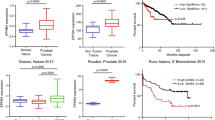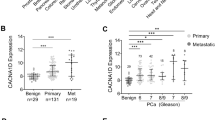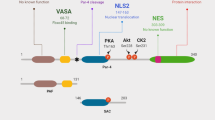Abstract
In order to identify gene products associated with the development of acquired therapeutic resistance by prostate cancer cells, we created two novel apoptosis-resistant prostate cancer cell lines, LNCaP-TR (phorbol-ester [TPA]-Resistant) and LNCaP-SSR (Serum Starvation-Resistant) by repeated transient exposure of cultured human LNCaP cells to apoptotic stimuli followed by expansion of surviving cell populations. These cell lines were found to be cross-resistant to the alternative selective agent and also hormone-resistant when xenografted into castrated male immunodeficient mice. RNA from the LNCaP-TR line was comparatively screened using a subtractive hybridization-PCR procedure. This allowed us to identify a 249 bp cDNA fragment that hybridized to a 4.8 kb mRNA preferentially expressed by the apoptosis-resistant cells. Using RACE procedures, we cloned and sequenced the complete 4.8 kb cDNA. It is an unusual member of the protocadherin gene family containing two large overlapping open reading frames encoding homologous polypeptides, one having a signal sequence and the other lacking a signal sequence and we refer to it as protocadherin-PC. LNCaP cells directly transformed with protocadherin-PC cDNA were comparatively resistant to phorbol-ester induced apoptosis. Antibody recognition studies demonstrating the cytoplasmic nature of the protcadherin-PC translation product and its propensity to bind β-catenin suggest that it might influence the apoptotic sensitivity of prostate cancer cells through a unique mechanism.
This is a preview of subscription content, access via your institution
Access options
Subscribe to this journal
Receive 50 print issues and online access
$259.00 per year
only $5.18 per issue
Buy this article
- Purchase on Springer Link
- Instant access to full article PDF
Prices may be subject to local taxes which are calculated during checkout






Similar content being viewed by others
References
Blanco P, Sargent CA, Boucher CA, Mitchell M, Affara NA . 2000 Mammalian Genome 11: 906–914
Brothman AR . 1997 Cancer Gen. Cytogenet. 95: 116–121
Bucher P, Karplus K, Moeri N, Hoffman K . 1996 Computers Chem. 20: 3–24
Buttyan R, Zakeri Z, Lockshin R, Wolgemuth D . 1988 Mol. Endocrin. 2: 650–657
Cheshire DR, Ewing CM, Gage WR, Isaacs WB . 2002 Oncogene 21: 2679–2694
Chirgwin JM, Przybyla AE, MacDonald RJ, Rutter WJ . 1979 Biochem. 18: 5294–5299
Craft N, Shostak Y, Carey M, Sawyers CL . 1999 Nature Med. 5: 264–265
Dasari VK, Goharderakhshan RZ, Perindchery G, Li LC, Tanaka Y, Alonzo J, Dahiya R . 2001 J. Urol. 165: 1335–1341
Diatchenko L, Lau Y-FC, Campbell AP, Chenchik A, Moqadam F, Huang B, Lukayanov S, Lukayanov K, Gurskaya N, Sverdlov ED, Siebert PD . 1996 Proc. Natl. Acad. Sci., U.S.A. 93: 6025–6030
Dignam JD, Lebovitz RM, Roeder RG . 1983 Nucleic Acids Res. 11: 1475–1489
Eddy S . 1998 HMMER User's Guide: Biological Sequence Analysis Using Profile Hidden Markov Models, Version 2.1, 1-70 St. Louis: Dept. of Genetics, Washington University School of Medicine
Furuya Y, Krajewski S, Epstein JI, Reed JC, Isaacs JT . 1996 Clin. Cancer Res. 2: 389–398
Grossman ME, Huang H, Tindall DJ . 2001 J. Natl. Cancer Inst. 93: 1687–1697
Hoffman K, Bucher P, Falquet L, Bairoch A . 1999 Nucleic Acids Res. 27: 215–219
Horoszewicz JS, Leong SS, Chu TM, Wajsman ZL, Friedman M, Papsidero L, Kim U, Chai LS, Kakati S, Arya SK, Sandberg AA . 1980 Prog. Clin. Biol. Res. 37: 115–132
Hsiao PW, Chang C . 1999 J. Biol. Chem. 274: 22373–22379
Huggins C, Hodges CV . 1941 Cancer Res. 1: 293–298
Karan D, Schmied BM, Dave BJ, Wittel UA, Lin MF, Batra SK . 2001 Clin. Cancer Res 7: 3472–3480
Krajewski S, Bodrug S, Krajewska M, Shabaik A, Gascoyne R, Berean K, Reed JC . 1996 Am. J. Pathol. 146: 1567–1576
Lau YF, Zhang J . 2000 Mol. Carcinogen. 27: 308–321
Marcelli M, Ittmann M, Mariani S, Sutherland R, Nigam R, Murthy L, Zhao Y, DiConcini D, Puxeddu E, Esen A, Eastham J, Weigel NL, Lamb DJ . 2000 Cancer Res. 60: 944–949
McDonnell TJ, Navone NM, Troncoso P, Pisters LL, Conti C, von Eschenbach AC, Brisbay S, Logothetis CJ . 1997 J. Urol. 157: 569–574
Murphy GP, Slack NH . 1980 Urol. Clin. North Am. 7: 631–638
Nielsen H, Engelbrecht J, Brunak S, von Heijne G . 1997 Protein Engineering 10: 1–6
Pearson WR . 1996 Methods in Enzymology 266 Doolittle RF (ed) San Diego: Academic Press pp 227–258
Raffo AR, Perlman H, Chen MW, Day ML, Streitman JS, Buttyan R . 1995 Cancer Res. 55: 4438–4445
Reese MG, Harris NL, Eeckman FH . 1996 Large scale sequencing specific neural networks for promotor and splice site recognition Hunter L and Klein TE (eds) Proceedings of the 1996 Pacific Symposium World Scientific Publishing Co., Singapore, 1996 pp 2–7
Resnick MI, Grayhack JT . 1975 Urol. Clin. North Am. 2: 141–161
Rost B, Casadio R, Fariselli P, Sander C . 1995 Protein Science 4: 521–533
Rost B, Fariselli P, Casadio R . 1996 Protein Science 7: 1704–1718
Shen R, Dorai T, Szabolcs M, Katz AE, Olsson CA, Buttyan R . 1997 Urol. Oncol. 3: 67–75
Smith TF, Waterman MS . 1981 J. Mol. Biol. 146: 195–197
Sonnhammer EL, Eddy SR, Durbin R . 1997 Proteins 28: 405–420
Stappert J, Kemler R . 1994 Cell Adhes. Commun. 2: 319–327
Suzuki ST . 1996 J. Cell Biochem. 61: 531–542
Takahashi S, Alcaraz A, Brown JA, Borell TJ, Herath JF, Bergstra EJ, Lieber MM, Jenkins RB . 1996 Clin. Cancer. Res. 2: 137–145
Taplin ME, Bubley GJ, Shuster TD, Frantz ME, Spooner AE, Ogata GK, Keer HN, Balk SP . 1995 N.E.J.M. 332: 1393–1398
Taplin ME, Bubley GJ, Ko YJ, Small EJ, Upton M, Rajeshkumar B, Balk SP . 1999 Cancer Res. 59: 2511–2515
Tricoli JV . 1999 Cancer Gen. Cytogenet. 111: 1–6
van der Kwast TH, Schalken J, Ruizeveld de Winter JA, van Vroonhoven CC, Mulder E, Boersma W, Trapman J . 1991 Int. J. Cancer 48: 189–193
Whang X, Yeh S, Wu G, Hsu CL, Wang L, Chiang T, Yang Y, Guo Y, Chang C . 2001 J. Biol. Chem. 276: 40417–40423
Wooton JC, Federhen S . 1996 Methods in Enzymology 266: Doolittle RF (ed) San Diego, CA: Academic Press pp 554–571
Yeh S, Lin HK, Kang HY, Thin TH, Lin MF, Chang C . 1999 Proc. Natl. Acad. Sci. U.S.A. 96: 5458–5463
Yoshida K, Sugano S . 1999 Genomics 62: 540–543
Zhang X, Colombel M, Raffo A, Buttyan R . 1994 Biochem. Biophys. Res. Commun. 198: 1189–1194
Acknowledgements
This work was supported by funding from US Department of Defense (DAMD-PC970137 and PC001565) and The TJ Martell Foundation for AIDS and Cancer Research, NY (to R Buttyan) and by l'Association de Recherche Contre le Cancer (ARC), le Comite des Hauts de Seine de la ligue centre le Cancer (to DK Chopin). Alexandre de la Taille was supported by a Fellowship from the French Urological Association–ARTP (France) and Francis Vacherot by a generous grant from Debat-Fournier, Inc. (France).
Author information
Authors and Affiliations
Corresponding author
Rights and permissions
About this article
Cite this article
Chen, MW., Vacherot, F., de la Taille, A. et al. The emergence of protocadherin-PC expression during the acquisition of apoptosis-resistance by prostate cancer cells. Oncogene 21, 7861–7871 (2002). https://doi.org/10.1038/sj.onc.1205991
Received:
Revised:
Accepted:
Published:
Issue Date:
DOI: https://doi.org/10.1038/sj.onc.1205991
Keywords
This article is cited by
-
PCDHGA9 acts as a tumor suppressor to induce tumor cell apoptosis and autophagy and inhibit the EMT process in human gastric cancer
Cell Death & Disease (2018)
-
Aberrant expression and functions of protocadherins in human malignant tumors
Tumor Biology (2016)
-
Human Chromosome Y and Haplogroups; introducing YDHS Database
Clinical and Translational Medicine (2015)
-
Beyond E-cadherin: roles of other cadherin superfamily members in cancer
Nature Reviews Cancer (2014)
-
Characterizing the Role of PCDH9 in the Regulation of Glioma Cell Apoptosis and Invasion
Journal of Molecular Neuroscience (2014)



